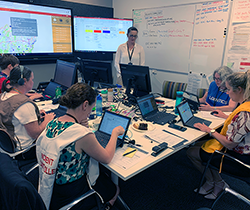EPA responds quickly to state-wide bushfire crisis
Over the past four months the EPA has undertaken an important role in bushfire response with a dedicated Bushfire Response and Recovery team working throughout the bushfire emergency and now into clean up and recovery.

The EPA Incident Response Room team was on duty for 112 days straight from November 2019
Throughout the height of the state-wide bushfire crisis, EPA staff worked around the clock to lead the state’s environmental response to the fires. This included staffing the State Emergency Operations Centre at Sydney Olympic Park to provide advice to the NSW Rural Fire Service (RFS) on potential environmental hazards and establishment of an EPA Incident Management Team which provided advice to government agencies, licensees and the community.
Acting Executive Director of the EPA’s Bushfire Response and Recovery Team Arminda Ryan said that a rotation of dedicated EPA staff were on duty for 112 straight days, including over the Christmas and New Year period, to provide environmental advice and information, for example, about licensed premises in the predicted fire path and about bushfire-generated waste.
“During the most intense month in January, our Environment Line received over 1,100 bushfire-related calls from the public. The Bushfire Response and Recovery team organised over 190 staff deployments including to multi-agency building impact assessment teams, at emergency operations centres as well as recovery centres. We’re grateful to all our staff who were involved in this huge effort,” Arminda said.
“EPA staff experienced in GIS mapping also assisted RFS and the National Parks and Wildlife Service (NPWS) with fire mapping,” she said.
The dedicated EPA Bushfire Response and Recovery team is now continuing the EPA’s work in the clean-up and recovery period which is expected to extend for many months.
“The Recovery team has deployed officers to over 67 teams to date across NSW to conduct building impact assessments with RFS, Public Works and other key agencies,” Arminda said.
“These assessment teams look at the damage to buildings and identify health and safety hazards residents may face when returning home, such as asbestos, ash from treated timbers, chemicals (garden, farm and household), damaged gas bottles and ash and dust.
“We are also providing expertise and support to councils in waste management given the huge volume of material that will need to be moved and safely disposed.”
The EPA’s commitment to the assessments is significant, with fire authorities reporting more than 2,700 homes and facilities destroyed and 1,200 more damaged.
“The EPA will continue to support our state agency colleagues throughout this enormous clean up and recovery process to help our devastated NSW communities get back on their feet as quickly as possible,” Arminda said.
Waiver on waste levy
To help people dispose of their bushfire generated waste quickly and easily, the NSW Government has waived the waste levy fee in areas across NSW that have been declared bushfire Natural Disaster Areas.
Residents should contact their local council before leaving home with their waste to confirm the names of the facilities where the levy is waived and their opening status. A list of council areas where the waste levy has been waived is available online.
The NSW Government has now appointed Laing O’Rourke Australia to lead the bushfire waste clean-up.
- More information and to register for clean-up, or
- phone enquiries, call 13 77 88.
The EPA has assisted in the development of waste plans for every local government area affected by the fires and no EPA approvals are required for the disposal of bushfire-related waste.

